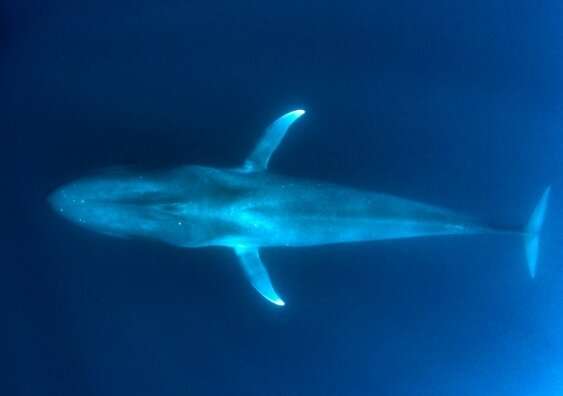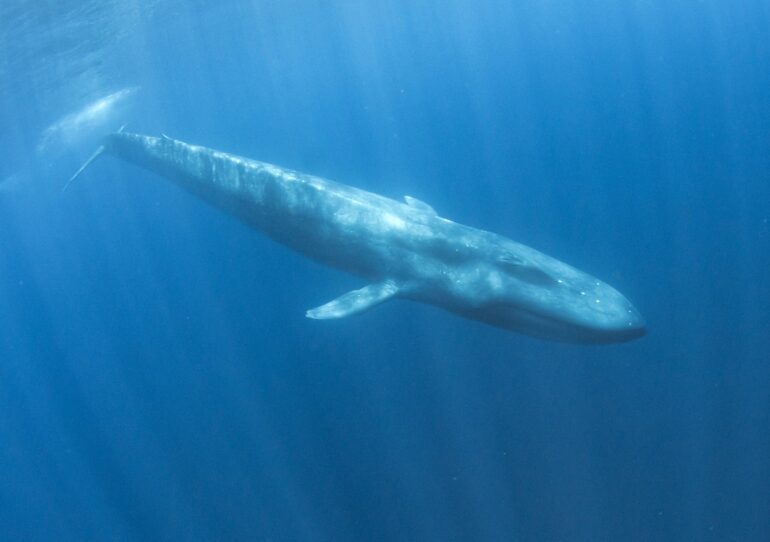You might think it’d be easy to track an animal as large as a blue whale. But don’t let their size fool you—they’re incredibly hard to study using conventional methods.
Not only are these large aquatic mammals quite shy and reclusive, they are also rather rare and can roam large regions of the ocean. But these elusive creatures also like to sing, and scientists can study their melodies to learn more about their behavior.
Researchers from UNSW Sydney have been using a network of underwater listening devices to keep tabs on pygmy blue whales off the coast of Western Australia. Their recent study, published in Frontiers in Marine Science, analyzed nearly two decades of continuous underwater recordings to see whether their calls correspond with environmental changes.
They found while the number of whale call detections changed year to year, the variability was linked to the climatic phenomenon, La Niña. The findings suggest climate cycles may influence the migration of the pygmy blue whale in the eastern Indian Ocean, which may have important implications for their conservation.
La Niña is the cooling phase of the naturally occurring El-Niño-Southern Oscillation (ENSO) cycle which causes variation in sea surface temperatures across the Pacific—though it is also known to have far-reaching effects on weather and ocean conditions worldwide, including the Indian Ocean.
“We found the number of detections was related to the strength and timing of La Niña events, suggesting it may be an important factor influencing their movements,” says Gary Truong, lead author of the study and a Ph.D. candidate at UNSW Science.
“More specifically, we found the number of song detections during La Niña years to be up to 10 times more than those in El Nino or neutral years, which indicates these whales respond to changes in climate cycles.”
Charting whale tunes
For the study, the researchers used acoustic data from a network of underwater sensors deployed in the Indian Ocean by the Comprehensive Nuclear-Test-Ban Treaty Organization (CTBTO). The devices, known as hydrophones, were originally designed to pick up unsanctioned nuclear testing. But they also happen to record the sounds of marine mammals such as pygmy blue whales.
“The song of the whale is a very low-frequency range these underwater listening devices pick up,” Mr. Truong says. “Their sounds are usually between zero to 100 hertz, which is lower than what we can detect with our ears.”
There are estimated to be around 10 different acoustic pygmy blue whale populations—the smallest subspecies of the blue whale—in the Southern Hemisphere, each with distinct sounds researchers can use to identify them. While the current assumption is that only male whales sing, the researchers can analyze the songs to gather information about the populations and their movements.
“More pygmy blue whale calls might indicate the whales are migrating in greater numbers and having more reproductive success,” Mr. Truong says. “Now that we’re out of La Niña, the number of calls we detect may decline, which could mean a period where the whales may not be as productive.”

Pygmy blue whales might be the smallest subspecies of blue whales but they can grow up to 24 meters long—almost the length of two buses. © Shutterstock
The emerging climate threat
The findings may have important implications for the management of pygmy blue whales in the region, which have been historically threatened by commercial whaling activity.
“Hunting once drove the species to the edge of extinction, and while they are now recovering slowly, their numbers haven’t bounced back strongly,” says Professor Tracey Rogers, senior author of the study and an ecologist from UNSW Science.
“From a conservation perspective, they are considered data deficient because we know relatively little about them, which is why studies like these are important.”
More information about the whale’s movements can help managers predict when more whales will migrate and help other ocean users to plan their activities.
“Commercial shipping and looking for oil and gas can be detrimental to the whales when they are present,” Mr. Troung says. “Managing those activities, particularly over the more active migration years, can help reduce the impact on these animals as they swim past.”
While they’re no longer in decline, the researchers say climate change also looms as a growing threat to the blue whales. As the ocean warms, it could change the availability of food sources such as krill, which the researchers suspect may be the main driver behind whether the whales undertake migration.
“Not only are we seeing the impacts of climate change on the terrestrial landscape, but also on the oceans and the animals within them,” Prof. Rogers says. “The science suggests we will see more frequent La Niña events. This will likely affect food availability for these large whales and perhaps put more stress on recovering population.”
The researchers say more research is needed to understand the impact of food availability changes during the La Niña years. They also plan to analyze more recent data to determine whether the recent triple dip La Niña event further impacted whale calls.
“The climate is changing quite rapidly, and the question is whether animals like the pygmy blue whale can adapt to these conditions in the long-term,” Mr. Truong says.
More information:
Gary Truong et al, La Niña conditions influence interannual call detections of pygmy blue whales in the eastern Indian Ocean, Frontiers in Marine Science (2023). DOI: 10.3389/fmars.2022.850162
Provided by
University of New South Wales
Citation:
Singing the blues: More whale songs detected during La Niña years (2023, April 14)



